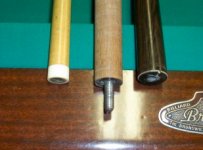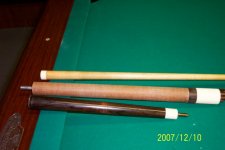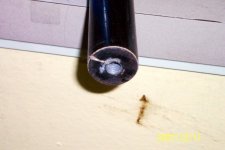I received this cue today from one of our members. The gentleman requested that I refinish this cue for him. I suspect that the cue ia a very early Huebler cue, however, I have not had time to contact Paul yet.
I understand how to complete the refinish on this cue, and how to build a tenon and properly re-asemble it at the A-joint.
Note: the A-joint came apart when I removed the cues wrap!!
My questions concern, first who made it, and has anybody ever seen an A-joint assembled in this manner, and if so why?
Here are the photo's!!



Oh and by the way, the shaft has a plastic insert like Hueber uses.
I understand how to complete the refinish on this cue, and how to build a tenon and properly re-asemble it at the A-joint.
Note: the A-joint came apart when I removed the cues wrap!!
My questions concern, first who made it, and has anybody ever seen an A-joint assembled in this manner, and if so why?
Here are the photo's!!



Oh and by the way, the shaft has a plastic insert like Hueber uses.
Last edited:


